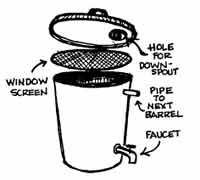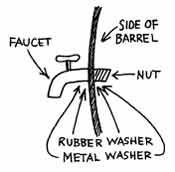What is Rainwater Harvesting?
Rain barrels capture water from a roof through the downspouts of your eaves troughs and hold it for later use such as on lawns, gardens or indoor plants. Collecting roof runoff in rain barrels reduces the amount of water that flows from your property.
The average roof in the CRD can collect 272 litres of rain (60 gallons) on each nine square metres (about 100 square feet) for every 25mm (one inch) of rain. This equals hundreds of litres of free water you can use in your garden every year, for only a small investment of time and materials.
How Much Water Can Be Collected?
The annual rainfall for the capital region is about 1660mm, with the majority falling from October to March. An average of 200mm falls from May to September.
To calculate the amount of rain that can be collected at each downspout in litres, determine the area of your roof, the depth of rainfall in millimeters and the number of downspouts. Put these numbers into the following calculation:
(rainfall amount in mm) x (rooftop area in m2)x (0.75*) / (number of downspouts)
*On average systems have a collection efficiency of 75%.
Connect storage containers together or install a cistern with a capacity of 750L (200 gallons) to 3800L (1000 gallons) to increase your harvesting capacity. Try this rainfall harvest calculator (in gallons).
Benefits of Rainwater Harvesting
- Saves treated drinking water.
- Free source of water.
- Delays peak runoff during a rainfall event which reduces the burden on our infrastructure.
- Reduces the pressure on storm drainage and the sanitary sewer system.
- Reduces soil erosion from the foundation of your home.
- Promotes healthy plants, as rain water is the ambient temperature, has micro-nutrients and is chlorine-free.
- Using rainwater for irrigation, will help to replenish groundwater stores.
Tips to Remember Before Installation
- Do not use untreated rainwater for drinking, cooking or bathing.
- Make sure your rain barrel has a secured lid to prevent access by children and wildlife, avoid breeding mosquitoes and reduce contamination.
- Use a piece of window screen to catch debris.
- Rain barrel material is strong enough to hold the weight of water, such as food grade plastic.
- Install an overflow attachment and hose attachment for watering.
- Position the barrel high enough to be able to place a bucket or watering can beneath the tap.
- Untreated rainwater from roof types such as copper, zinc (galvanized metal), chemically treated wood shingles or shakes, asphalt shingles, or those treated with chemicals may not be suitable for watering vegetable gardens.
- Empty the rain barrel after each rainfall in the winter and spring to make sure it is ready to capture the next rainfall. This helps reduce peak runoff and the burden on infrastructure.
- When designing and installing capture systems, or making modifications to your property or drainage flow, consider provincial and municipal codes, regulations and standards.
- If your rainwater harvesting system is connected to the municipal drinking water lines, a cross connection control device (RPPA) is required on the potable water connection to prevent rainwater backflow into the system.
DIY Rain Barrels
A do- it-yourself rain barrel can be a great option. For a very small investment of time and materials, you can collect hundreds of litres of free water for your garden every year. Check out Okanagan WaterWise Building A Rain Barrel video tutorial and PDF


Provision of this information does not represent an endorsement by the CRD of the conclusions reached by studies or a recommendation of any of products or techniques.
Reduce Stormwater Runoff
As the communities across the capital region continue to grow, there are more impervious surfaces and less forest and wetland. Rain quickly moves from our roofs, streets and parking lots to storm drains that enter local waterways and shorelines. This intense runoff picks up various pollutants along the way including oil, metals and bacteria.
Green stormwater infrastructure such as green roofs, rain gardens, living walls and permeable paving help reduce stormwater runoff. This infrastructure replenishes groundwater, protects waterways and aquatic habitats, improves water quality and can reduce property damage caused by flooding.